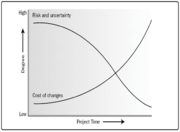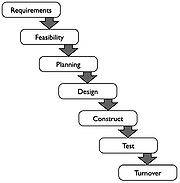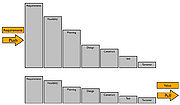Waterfall vs. Pull Processes
(→Pull Process) |
(→Pull Process) |
||
| Line 109: | Line 109: | ||
=Pull Process= | =Pull Process= | ||
The purpose of pull planning is to create a project plan with lean principles. In contrast to the waterfall resp. the push process is the pull process defined by an overlapping system. Therefore, the phase has not to be finalized until the next phase starts, the flow between the phases is more interlocked. The pull process is a common process in the lean management philosophy, it helps to avoid waste of time and money. Additionally, the total workload is smaller due to the elimination of unnecessary tasks and processes. | The purpose of pull planning is to create a project plan with lean principles. In contrast to the waterfall resp. the push process is the pull process defined by an overlapping system. Therefore, the phase has not to be finalized until the next phase starts, the flow between the phases is more interlocked. The pull process is a common process in the lean management philosophy, it helps to avoid waste of time and money. Additionally, the total workload is smaller due to the elimination of unnecessary tasks and processes. | ||
| + | |||
| + | [[File:Pull Process.jpg|thumb|Pull Process]] | ||
| + | |||
The common definition of the pull process is, that the customer pulls the value from the project team, but not just the customer is pulling, the subsequent is pulling as well. Thereby, the subsequent is giving the impulse and states in this way when the next phases is starting. Typical pull processes can find in the Kanban or in the Scrum methodology and make those models more flexible and reduces the waste. | The common definition of the pull process is, that the customer pulls the value from the project team, but not just the customer is pulling, the subsequent is pulling as well. Thereby, the subsequent is giving the impulse and states in this way when the next phases is starting. Typical pull processes can find in the Kanban or in the Scrum methodology and make those models more flexible and reduces the waste. | ||
In total the pull processes avoid delivering value before the customer or a colleague request it. In addition, the pull processes avoid the provision of more than the agreed initial scope, it allows the implementation of a just-in-time system. | In total the pull processes avoid delivering value before the customer or a colleague request it. In addition, the pull processes avoid the provision of more than the agreed initial scope, it allows the implementation of a just-in-time system. | ||
| − | |||
As distinguished from the push process, where the team leader is "pushing" the tasks to his team members, and put in this way work on a "to-do" list, pull processes allow the team members doing the work when they are ready. Hence, pull processes prevents team members from stress and work on results which will be eliminate in a later stage. A big benefit for the project work is, that tasks or items can be prioritized. In this way the project manager can work with his team on the right tasks at the right time while reducing wasted time or effort. | As distinguished from the push process, where the team leader is "pushing" the tasks to his team members, and put in this way work on a "to-do" list, pull processes allow the team members doing the work when they are ready. Hence, pull processes prevents team members from stress and work on results which will be eliminate in a later stage. A big benefit for the project work is, that tasks or items can be prioritized. In this way the project manager can work with his team on the right tasks at the right time while reducing wasted time or effort. | ||
Revision as of 17:35, 26 February 2018
There are many different methodologies of project management, all of them are defined by different principles and processes. A traditional, sequential methodology, is the waterfall model. Within this model, the tasks of the project plan are sequenced and conducted in a linear way, one task must be completed before the next one begins - the process is smooth and continuous, like a waterfall. Therefore, this model is one of the simplest methods. However, the pull process-based methodologies are used to create the whole project plan more efficient and effective, it was created to eliminate confounding factors within the project and to avoid aimless work. Hence, the pull processes are used in the management style of Lean Project Management, typical pull processes can be find in the Scrum and Kanban methodologies. This article provides an introduction to the waterfall methodology, to understand the processes within a project plan in a better way. However, the article provides a comparison of the waterfall process (push process) and the pull process. Therefore, no other methodologies e.g. Scrum and Kanban are explained. For the comparison of the two different processes are pros and cons described and the relevance for the practical usage demonstrated.
Contents |
Importance for Project Management
A project is divided in several phases (except the single-phase project), and five project groups.
1. Initiating Process Group:Those processes performed to define a new project or a new phase of an existing project by obtaining authorization to start the project or phase.
2. Planning Process Group: Those processes required to establish the scope of the project, refine the objectives, and define the course of action required to attain the objectives that the project was undertaken to achieve.
3. Executing Process Group: Those processes performed to complete the work defined in the project management plan to satisfy the project specifications.
4. Monitoring and Controlling Process Group: Those processes required to track, review, and regulate the progress and performance of the project; identify any areas in which changes to the plan are required; and initiate the corresponding changes.
5. Closing Process Group: Those processes performed to finalize all activities across all Process Groups to formally close the project or phase.
The project manager has to combine those phases into a flow and take into account the product or service, his team and the customer. To establish a real customer value the project should set up a scope baseline control, build a communication plan to improve the information flow, asses stakeholder needs and get the commitment of the internal stakeholder. As a result, there are many factors which have to be intertwine to each other. Thus, project managers are inclined to overlook something at the beginning of the project and this is when project wastes start building. It is important to align with the customers to establish the customer value, but if the customer is deflect the project team members it will be end in scope creep. As an interim conclusion, the project planning has to consider a lot of things simultaneously, but it is also very important to ponder in which way and rate the steps are executed.
A project life cycle displays typically four characteristics:
1. The costs and staffing level starts at the beginning of the project low, increase when the work is carried out and decrease quickly when the project is going to close.
2. Not all projects describe a typical cost and staffing curve, they may require resources early in its life cycle and therefore higher expenditures.
3. A project starts with a high amount of risk and uncertainty and run low during the ongoing life cycle.
4. The influence to the final product/service starts on an high level with low costs. At the beginning of the cycle the vision can be adjust rapidly and economically, changes at the end of the project will cause high expenses.
With this description of the characteristics of a project life cycle, we can have a look to the different life cycles, which are designed for different purposes. The main difference of the waterfall model and the pull processes is the influence of the stakeholder and the degree of flexibility. Adaptive life cycles keep stakeholders in the loop and let them influence the project in a higher degree than a predictive life cycle (waterfall). Since, the project plan within a adaptive life cycle is more flexible the costs of changes are lower.
The importance to think about the way how to execute the project and how flexible and influenceable it should be is enormous. Therefore, the following chapters will provide some clarity about the choose of process styles.
Waterfall Process
The waterfall model (also known as predictive life cycle or fully plan-driven) is made of a waterfall process, which is defined by sequential relationships. A phase, consisting generally all five process groups, starts only when the previous phase is complete. This approach reduces uncertainty within the project life cycle, but it requests a high amount of tasks. As a result, this process is defined by a huge workload. In addition, the project scope, and the time and the cost required to deliver that scope, are determined at the beginning of the project life cycle. Therefore, the project is inflexible and changes are related to high costs. The waterfall model is preferred when the product or service to be delivered is well understood and the following processes describe the waterfall model.
Requirements
Firstly, the project team need an understanding of the project's function, purpose etc, the specifications of the input and output of the final product or service are studied and marked.
Feasibility In the feasibility phase, the target is about finding out all the potential problems. The problems should be evaluated and analyzed and considered for the decision making process.
Planning When the boundary conditions are clear and all parameters marked out, the project team can begin with the planning phase. In this phase all the next steps are described in detail, and are linked to each other. The team leader is pushing the future tasks to the team members.
Design The requirement specification is used to transfer the gathered date into a system design. At the end of this phase the members should know how the product looks like.
Construct
With the input of the last phase, the system design is implemented to the product - the product or service is constructed.
Test
After the construction, all the parts have to be tested, so that the customer does not face any trouble.
Turnover Once the testing is done, the product is released into the market or deployed in the customer environment. After the release it is possible to make modifications to the product/service/system.
With the waterfall model, the different sequences and the sequential relationship in mind, it is important to know that in this flow of processes, the tasks are pushed by the team leader to the project team members. Although it's resulting in a higher amount of workload, the tasks are handled step-by-step, even when the result is not used in the next phase anymore. This work method is attributed to the planning in the early stage of the project.
Pros
- Easy to use and understandable due to documentation for every phase
- The team leader is distributing the tasks to the team members - no further training required
- Easy to manage and control due to defined structure and deadlines
- The agreement between project leader and customer in the early stage of the project life cycle makes the planning more straightforward
- Since the full scope of work is known at the beginning, the measurement of progress is easier
Cons
- High workload
- Difficult to pinpoint everything at the beginning - limited by specific details
- Unsatisfied customer due to little involvement and flexibility
- Changes are difficult and costly to implement
- Given deadlines can cause stress and limited scope of action
Pull Process
The purpose of pull planning is to create a project plan with lean principles. In contrast to the waterfall resp. the push process is the pull process defined by an overlapping system. Therefore, the phase has not to be finalized until the next phase starts, the flow between the phases is more interlocked. The pull process is a common process in the lean management philosophy, it helps to avoid waste of time and money. Additionally, the total workload is smaller due to the elimination of unnecessary tasks and processes.
The common definition of the pull process is, that the customer pulls the value from the project team, but not just the customer is pulling, the subsequent is pulling as well. Thereby, the subsequent is giving the impulse and states in this way when the next phases is starting. Typical pull processes can find in the Kanban or in the Scrum methodology and make those models more flexible and reduces the waste. In total the pull processes avoid delivering value before the customer or a colleague request it. In addition, the pull processes avoid the provision of more than the agreed initial scope, it allows the implementation of a just-in-time system.
As distinguished from the push process, where the team leader is "pushing" the tasks to his team members, and put in this way work on a "to-do" list, pull processes allow the team members doing the work when they are ready. Hence, pull processes prevents team members from stress and work on results which will be eliminate in a later stage. A big benefit for the project work is, that tasks or items can be prioritized. In this way the project manager can work with his team on the right tasks at the right time while reducing wasted time or effort.
Pros
- Supports the continuous flow of work
- Work is done as a team
- Involvement of customer
- Allows better planning and prioritization of work
- Continuous delivery by eliminating the waste and focusing on continuous improvement
- Increase productivity and speed up task delivery
- Decrease stress level of project team members
- Reduce waste of time and money.
Cons
Waterfall vs. Pull
Summary pros cons. Workload image




